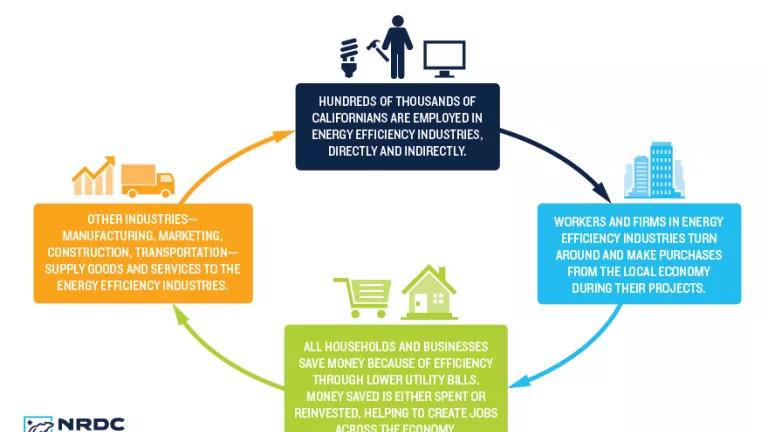Keep California’s Efficiency Progress Strong: Update Rules

Even as the Trump administration disregards the burgeoning worldwide clean energy economy, California continues to advance its leadership. The latest evidence: The energy efficiency programs serving most of the customers in the state provided another year of substantial energy savings, building on decades of progress.
Efficiency program administrators—the state’s four largest investor-owned utilities (responsible for about three-quarters of the state’s electricity needs), Marin Clean Energy, the Bay Area Regional Energy Network, and the Southern California Regional Energy Network—exceeded their goals last year when measuring success by the parameters set when programs were originally approved.
In just one year, the achievements from these programs avoided emissions comparable to the annual pollution spewed from more than 350,000 cars, cut enough electricity equivalent to the output from more than one large power plant, and saved customers more than $400 million on their energy bills.
These programs (run by program administrators, local governments, implementers, and contractors) saved nearly 3000 gigawatt-hours, 550 megawatts, and more than 50 million metric therms of natural gas while collectively exceeding their goals by as much as 124 percent.
Long an energy-efficiency leader, California invests over $1 billion annually in these programs, which offer returns not only in the form of saved energy and cleaner air, but also by supporting jobs in the clean energy sector and avoiding the need to build new power plants. These programs extend across homes and businesses, from helping homeowners upgrade appliances to providing technical support and rebates for farmers to install more efficient irrigation equipment.
Since the 1970s, California’s energy efficiency efforts have saved residents nearly $90 billion on their energy bills while also supporting a growing economy. The state has avoided building 50 large power plants, and will avoid the need for about 11 more over the next decade. California is also providing an example to follow as states across the country seek ways to cut carbon emissions, boost grid reliability, and create jobs.
While California has made great strides relying on energy efficiency as a cost-effective tool to meet climate goals, much more needs to be done if the state is to double its energy efficiency achievements by 2030, as mandated by the Clean Energy and Pollution Reduction Act of 2015 (SB 350).
Over the next year, the state should focus on providing clear and effective guidance at the California Energy Commission and the California Public Utilities Commission—the two main energy agencies that set policy for the state and oversee the implementation of energy efficiency programs—in order to ensure more energy savings.
The California Public Utilities Commission—which oversees the investor-owned utilities, Marin Clean Energy, and the Regional Energy Networks—should:
- Approve the program administrators’ business plans as soon as practical to provide the framework for energy efficiency programs over the next 10 years and enable the efficiency industry to launch new efforts and expand tried-and-true programs;
- Use the California Technical Forum to establish accurate energy-saving estimates in a timely manner to allow for new programs to be tried, reduce disputes, and transform markets faster;
- Ensure the Commission’s forthcoming efficiency potential study identifies all potential savings without restricting opportunity based on savings or budgets from previous years and builds on current strategies to include updated low-income and innovative solutions that can be deployed over the next several years;
- Fully implement the new directives in the Energy Savings Assistance Program Commission decision, including by launching a new multifamily whole-building program; and
- Re-evaluate current policies to:
- Provide an opportunity for additional market transformation programs;
- Ensure that cost-effectiveness tests, which the CPUC uses to determine program budgets, account for societal costs and benefits in line with state clean energy and climate laws;
- Modify evaluation techniques to capture meaningful information that can be used to improve efficiency efforts; and
- Fully implement state laws such as those directing existing baseline measurements (AB 802) and addressing barriers to clean energy in low-income and disadvantaged communities (SB 350).
The California Energy Commission—which oversees public utilities like the Los Angeles Department of Water and Power and sets policy direction for the entire state—should:
- Adopt a building benchmarking and data transparency policy to motivate and enable building owners and occupants to save energy, including sufficient outreach and support resources to implement the policy;
- Oversee the full implementation of the 12 recommendations provided in the California Energy Commission’s study of barriers to low-income energy efficiency programs; and
- Establish an inclusive and transparent statewide collaborative to implement the recommendations in the California Energy Commission’s Assembly Bill 758 Energy Efficiency Building Action Plan, which guides state action on improving workforce standards, efficiency financing, comprehensive retrofits, among other strategies to ensure wide scale existing building efficiency upgrades.
By setting up a clear and effective policy structure, California leaders can enable all stakeholders—including administrators, implementers, contractors, and customers—to scale up energy savings, the state could unlock substantial remaining savings, yield even more benefits for all Californians, and reach our climate targets cost-effectively and on time.

